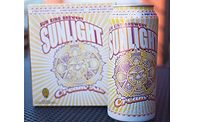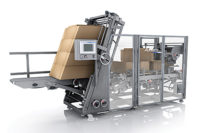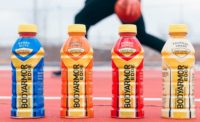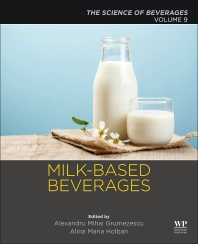Paper-based secondary packaging supports brand growth
Secondary packaging helps enhance shelf presence

Heineken and Heineken Light brands introduced new secondary packaging for the brands’ six-, 12-, 18- and 24-packs. The carriers feature modern graphics that reinforce the upscale attributes of the brands and help them to stand out on the shelf, in cold box and on display, the company says. (Image courtesy of Heineken USA)

Premium gift sets are becoming more popular in the spirits category, according to ASG’s Leon Hill. (Image courtesy of The Rolling Stones Crystal Head Vodka)


When the recession hit, consumers started purchasing fewer items on shopping trips, in effect adding importance to a product’s packaging to get shoppers to pick up the product and examine it, says Charles Pavia, director of marketing for Proactive Packaging & Display, Ontario, Calif.
“Most people don’t realize that 66 percent of all packages that get touched on the shelf will wind up getting put in the shopping cart,” he says.
In fact, a study found that packaging in-store is the No. 3 media vehicle to drive purchase consideration, behind in-store offers and Internet searches, says Zack Smith, president of the beverage business unit of MeadWestvaco Corp. (MWV), Richmond, Va.
Therefore, a product’s packaging can play a major advertising role — especially in the case of smaller companies, such as craft brewers, Proactive’s Pavia notes.
“You’ve got to attract the person when they’re moving their cart down the aisle, and you only have seconds,” he says. “Your packaging’s got to connect with the heart and convince the mind in a matter of seconds.” To do so, brands should use graphics to catch the shopper’s attention and copy to resonate with the shopper’s values, he explains.
Shelf-ready case designs and printing can reinforce the brand at the point-of-sale, adds Don Reggio, marketing manager for RockTenn, Norcross, Ga.
The strength of the material also is vital to the product’s performance, experts say. Not only must the secondary packaging material make it through the entire distribution cycle safely and aesthetically, it also needs to live up to shopper expectations, says Tom Zumbiel, marketing director for Zumbiel Packaging, Hebron, Ky. For instance, shoppers typically won’t notice the handle on a multi-pack of soda unless it fails, dropping cans of soda to the floor, he explains.
RockTenn offers a line of high-strength coated recycled board that is specially engineered to provide high stiffness, dimensional squareness and high tear strength while maintaining a smooth print surface for eye-catching graphics, it says.
Paper-based secondary packaging with wet strength also is important for categories like beer, where an entire case might be placed into a bucket of ice to chill, Zumbiel Packaging’s Zumbiel adds.
What’s trending
As the number of beverage brands and brand extensions continue to proliferate, consumers are faced with more and more choices, Zumbiel Packaging’s Zumbiel says. As these new SKUs become popular, their packaging formats often change, he notes.
When brands come out with something new, they often start out in single-serve containers, Zumbiel explains. Then, in order to stay in business and grow the brand, they expand into multi-packs, he adds.
For instance, energy drinks used to be available in single-serve containers at convenience stores primarily, but now they have evolved into other channels in four-, eight- and 12-packs in order to grow, he notes. With a premium appearance, paperboard is a good option for brands that are going from a single-serve product to a multi-pack, he says.
In the spirits category, premium gift sets are becoming more popular, says Leon Hill, global account team executive for ASG, Los Angeles. For instance, earlier this year Universal Music Canada and Crystal Head Vodka joined forces with The Rolling Stones to create an exclusive, limited-edition Rolling Stones 50th Anniversary Gift Set. The case features a real zipper, recalling the band’s “Sticky Fingers” album cover.
“The value in paperboard is the freedom to create and design using a nearly limitless portfolio of colors, textures and finishes to drive customer interest,” Hill says.
MWV’s Smith adds that paper-based packaging allows brands to enhance their graphic designs by incorporating elements such as high-gloss varnish, ultraviolet coatings, embossing, foil laminates, 3-D graphics, and digital and backside printing features.
ASG, for example, offers its proprietary Holoklear rainbow hologram effect in a press-applied coating. The company also notes a trend away from corrugate material to solid fiber, which allows the customer to embrace complex emboss and matte gloss patterns, says Keith Kiedinger, senior vice president of sales for ASG’s consumer packaging business.
However, within the corrugated containerboard segment, Proactive’s Pavia says the No. 1 trend is “kraft” packaging with higher-quality graphics.
“Kraft or brown [packaging] is starting to make its way back into the marketplace, but the print quality on the kraft is not what you would consider to be print quality on a brown shipper that is used to deliver to the back of a grocery store,” he explains. “These graphics are much sharper and cleaner and have impact, but yet the objective is to convey to the customer that the packaging is sustainable.”
Convenience also remains important to shoppers, according to experts. Zumbiel Packaging’s Zumbiel notes that the fridge pack is the most popular paper-based secondary packaging format, while MWV’s Smith says that basket carriers also are among the market’s most popular offerings.
“These secondary packaging options help solve two common consumer pain points [and offer] important benefits for the brand owner,” Smith says. “For example, opening features and easy refrigerator storage are important to consumers, while features like billboard space and the ability to increase supply chain efficiencies are important to brand owners.”
Looking for a reprint of this article?
From high-res PDFs to custom plaques, order your copy today!










